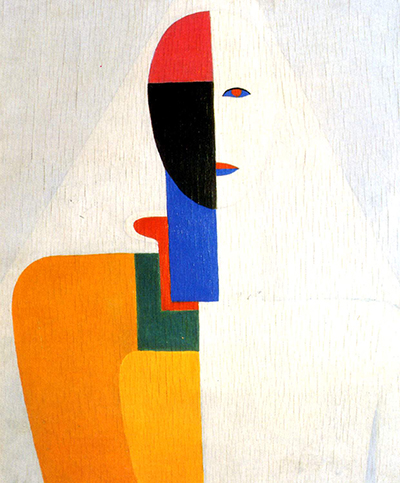Within the 1930s, artist Malevich would regularly produce figurative portraits in abstract forms where facial features were entirely removed. We that here again within Woman Torso, sometimes known as Female Torso.
This simple but memorable artwork divides a head and torso in two through the variation of colour. The figure faces us with their right hand side filled with flat planes of colour, whereas their opposing side is almost entirely delivered in white, with just a subtle outline to differentiate the body from the white background behind, in a similar way to his famous White on White painting. The colours on the more interesting side include reds, black, and a sort of mustard yellow for the shoulder area. The eyes only appear on one side because they are completed in black, meaning on the coloured side they are hidden. This type of approach feels like symbolism, where Malevich would be trying to communicate something about the figure by depicting them in this way, but it is worth remembering that he also used this style to capture non-descript items as well, and so potentially it may have just been him experimenting with aesthetic delivery rather than necessarily looking particularly deeply.
The artist would pass away just a few years after this painting was produced and so it represents the style in which he mainly worked during his last few years. By this point he had already left behind an impressive legacy which was influential right across Europe and certainly pricked the interest of modern artists in Western Europe. He was also contributing to a large body of work from Russian artists that really played an important role in the direction of European art during this period, even though some of them were forced to leave the nation in order to really express their creative ideas as best as possible. He himself would gift us the likes of Black Circle, Dynamic Suprematism and Red Square as part of a large oeuvre which survived to the present day, even though some would try to surpress his work, even destroyed some of his paintings in his later life.
Those classic paintings were truly abstract, where no connection to reality could be found, but he also achieved success with paintings such as Female Torso, where there was clearly some identifiable elements within the work. These sat in a middle ground between realism and abstraction and some actually prefer these artworks to his more abstract pieces. We must remember that he was initially trained and educated around Impressionism and Post-Impressionism, where expression was important but also delivered within tried and tested environments, such as the genre of landscape painting. He wanted to challenge everything that had gone before, not in a disrespectful manner, but in a way that could bring new ideas into the art world and essentially push things on again. He proved entirely successful in this desire and remains one of Russia's most famous artists.




